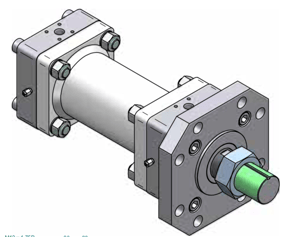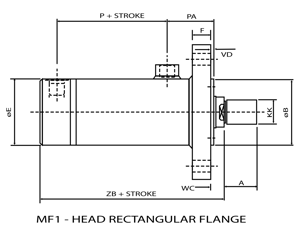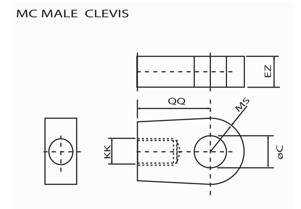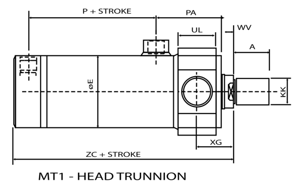
Misalignment is a common cause of hydraulic cylinder failure. After all, hydraulic cylinders are linear actuators designed to deliver force in a single direction. So, deviations from the centreline of the workload place lateral stress on cylinder pistons, seals, bushes and rods. These components are not designed to withstand these forces so they will fail very quickly.
For this reason, it’s important to choose the correct mounting option to allow the cylinder to perform the required task while minimising misalignment. There are several types of cylinder mounts, each of which is designed to achieve different ranges of motion or to deal with different forces encountered in the application.
The wrong choice of mounting option will increase wear causing the cylinder to fail in short order. Choosing the correct mounting option avoids problems like side loads that cause excessive seal and bearing wear, or even bend the rod or bind the load. With this in mind, here are the different types of mounting options available for your hydraulic cylinders.
HYDRAULIC CYLINDER MOUNTING OPTIONS
Flange mounts:

The Flange mount is a method of mounting the cylinder off the head itself. It is essentially a flat plate through which the cylinder rod is passed and secured. No joints or bearings are involved and the mount is fixed in the center-line of the cylinder. As such, this type of mount provides a high degree of strength and rigidity, allowing the greatest transmission of power because there is little energy lost through flexing and pivoting. The downside of this mounting style is that it leaves no room for lateral movement and is very intolerant of misalignment.
Flange mounts are an excellent choice for stationary cylinders since these allow strong, rigid linear force transfer with minimal wear. However, great care must be exercised when positioning the cylinder to ensure correct alignment of the piston rod in relation to the centreline of the workload.
Clevis Mounts:

Clevis mounts are pivot mounts and allow the cylinder to pivot in a single range of motion. This type of mount is useful in applications where the cylinder is required to pivot through an arc during extension and retraction. This makes it a common mounting type, especially for mobile equipment such as excavator booms. A mounting bracket is fixed to the end of the cylinder rod and inserted into the clevis where it is held in place with a steel pin held in place with cotter pins or snap rings - forming a pivoting joint assembly.
Clevis mounts are most often used for short stroke and small to medium-bore cylinders. They have the advantage of centerline mounting, but since they only allow for one range of motion, they are vulnerable to side-load issues. For this reason, spherical bearings are often used in clevis mounts to allow for some degree of misalignment to improve cylinder longevity.
Trunnion mounts:
 The word “Trunnion” originates from the French word “Trognon”, which literally means “Trunk”. These are cylindrical protrusions that form a mounting point, much like the stump of a tree. Trunnion mounts originally appeared on the heavy canons that you’ve probably seen on old wooden battleships - where they were used as a mounting point, which allowed the canon to pivot up and down.
The word “Trunnion” originates from the French word “Trognon”, which literally means “Trunk”. These are cylindrical protrusions that form a mounting point, much like the stump of a tree. Trunnion mounts originally appeared on the heavy canons that you’ve probably seen on old wooden battleships - where they were used as a mounting point, which allowed the canon to pivot up and down.
Hence, Trunnion mounts are type of pivot mount, which features trunnion pins that protrude from the cylinder. Depending on the style, these trunnion pins can be positioned at various places along the cylinder. Either at the head, cap, and intermediate-fixed trunnion. Trunnion mounts also allow the cylinder rod to traverse through an arc during extension and retraction. They are slightly stronger and more stable than a clevis mount and as such, trunnion cylinders experience smoother movement with less play in the joint compared to a clevis.
Lug mounts:
Lug mounts are a fixed-style mounting option that features rectangular tabs machined from or welded to the head and cap of the cylinder. This style of mount offers excellent rigidity and strength but suffer from the same intolerance of misalignment experienced by other fixed cylinder mounts. This causes more issues if the cylinder is mounted off the center-line of the cylinder workload as is the case of side-lug mounts.
Side lug mounts are attached to the machine on one side only and provide a fairly rigid mount, but because the plane of movement is offset, side-lug cylinders produce a torque effect as the cylinder extends. While this effect is not significant when the cylinder is fully extended, binding increases as the piston retracts. For this reason, machine members that act as mounting points for side lug mounts are often reinforced to resist bending during heavy loads and high-shock conditions to minimise lateral-loading.
Reduce cylinder failure - choose the right mounting option.
On the one hand, lateral loading caused by misalignment is by far the major cause of premature cylinder failure. On the other hand, the good news is this type of failure can be minimised by selecting the correct cylinder mounting point and ensuring correct alignment to eliminate side-loading away from the cylinder centerline which wears the bearings and seals.
For advice and assistance making the right choice, contact Berendsen and we’ll be glad to assist you.








Leave A Comment